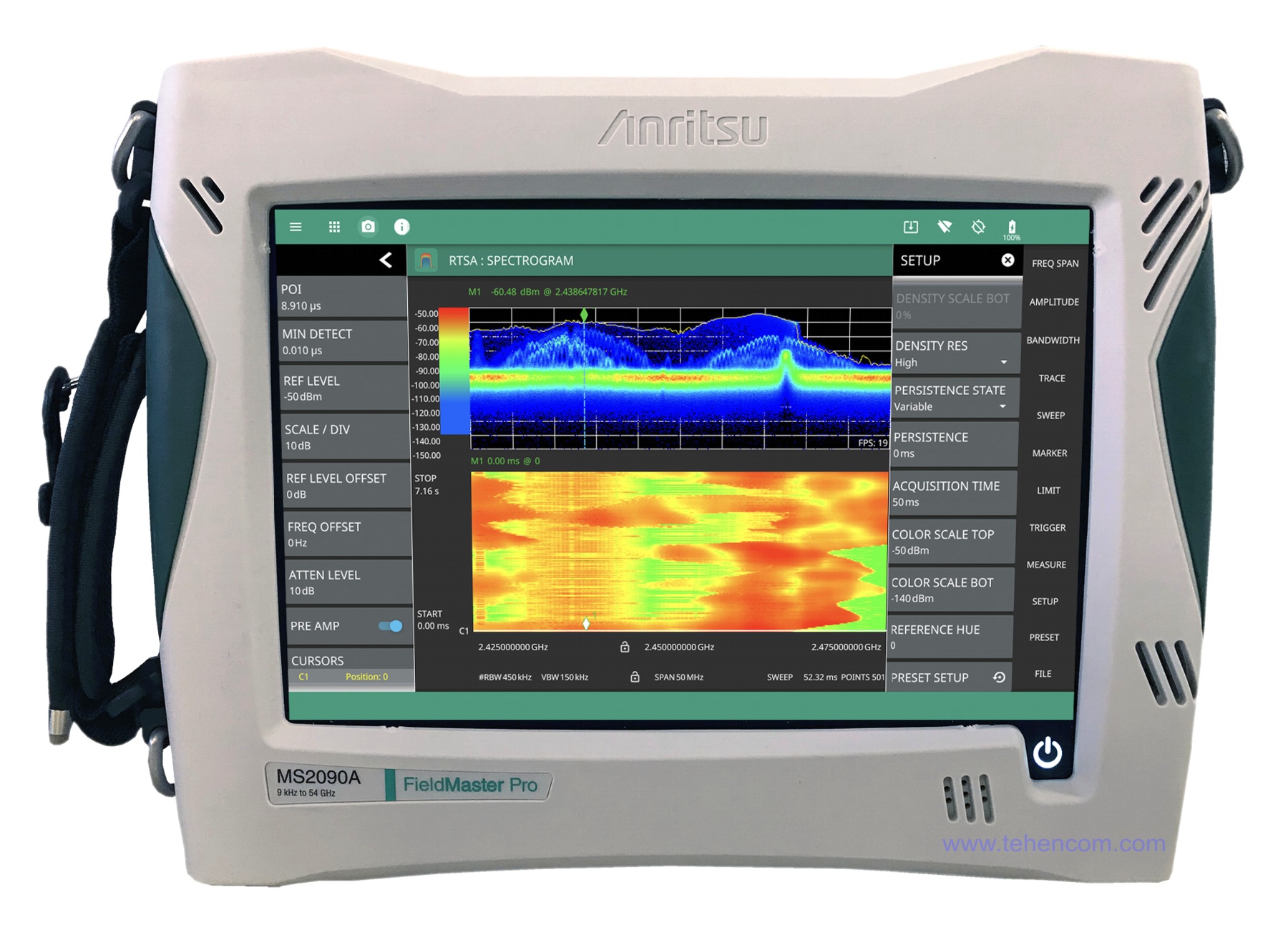Analyzer series up to 44.5 GHz with analysis bandwidth up to 1 GHz Anritsu MS2850A
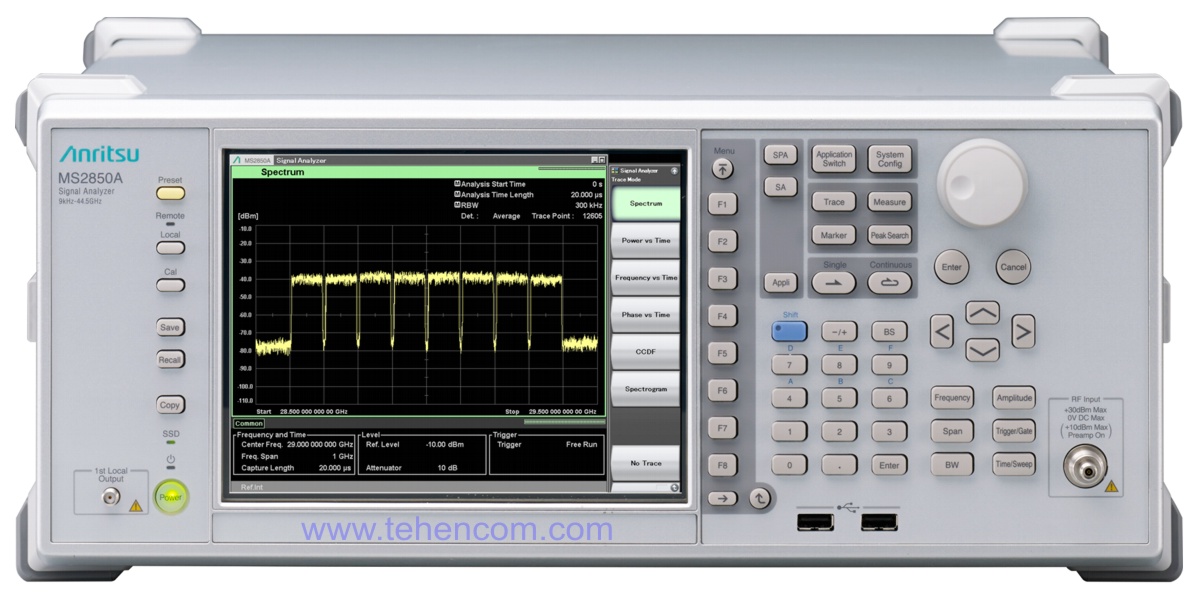
Brief description of the series
The Anritsu MS2850A series is designed to analyze signals with digital modulation bandwidth up to 1 GHz at a carrier frequency up to 44.5 GHz. In addition to a wide demodulation bandwidth, the MS2850A series analyzers have good linearity and dynamic range, which provide high measurement accuracy (EVM less than 1%). These analyzers are ideal for the development and maintenance of equipment for telecommunication networks of all generations (3G, 4G, 5G), as well as for satellite communication systems and any other application that uses digitally modulated signals.
When developing the MS2850A series, Anritsu optimized its functional diagram and software to create the ideal tool for today's and tomorrow's communications systems. The capabilities of these analyzers allow you to fully provide the entire cycle of development, debugging, production, configuration and repair of equipment. And the record-breaking 1 GHz demodulation and analysis bandwidth allows you to perform work that was not possible before, for example, to simultaneously test 8 channels of 100 MHz each. A full description of all the characteristics of the Anritsu MS2850A can be downloaded below on this page in the Documentation section.
All models of the series
The Anritsu MS2850A series consists of two models, which are presented in this interactive table. To see all the characteristics of certain models, add them to the comparison.
| Model |
Maximum frequency
|
Signal analysis bandwidth
|
Maximum amplitude
|
Average noise DANL
|
SSB phase noise
|
Weight
|
|---|---|---|---|---|---|---|
|
MS2850A-047
|
32 GHz | 255 MHz 510 MHz 1 000 MHz | +30 dBm | -153 dBm -166 dBm | -123 dBc/Hz | 21 kg |
|
Expert's choice
MS2850A-046
|
44.5 GHz | 255 MHz 510 MHz 1 000 MHz | +30 dBm | -153 dBm -166 dBm | -123 dBc/Hz | 21 kg |
Main features of the series
Frequency: 9 kHz - 32 GHz (model MS2850A-047).
Frequency: 9 kHz - 44.5 GHz (model MS2850A-046).
Resolution (RBW): 1 Hz - 10 MHz.
Amplitude: +30 dBm to -166 dBm. Amplitude Accuracy: ±0.5 dB (up to 4 GHz).
Phase noise at 1 GHz: -123 dBc/Hz (10 kHz offset).
Standard: demodulation of signals up to 255 MHz bandwidth. EVM less than 1%.
Options: preamplifier, phase noise measurement, noise figure measurement (noise factor), analysis bandwidth 510 MHz, analysis bandwidth 1 GHz, reduction of the second harmonic.
Screen 21.3 cm (resolution 1024 x 768). Interfaces: USB, Ethernet, IEEE-488 (GPIB).
Weight: 21 kg. Dimensions: 426 x 177 x 390 mm. Working temperature: from +0°С to +45°С.
Spectrum and signal analyzers Anritsu MS2850A belong to the middle price range, but at the same time, have the ability to analyze signals with digital modulation, which surpasses even the most expensive models on the market. The MS2850A Series analyzers were originally designed as the primary tool for the development and deployment of 5G networks and other advanced broadband communications systems such as communications satellites and radio relay stations.
These instruments come standard with a 255 MHz digital demodulation bandwidth and software that provides measurements of all key spectrum parameters and a basic set of signal characteristics. With the help of hardware and software options, which can be viewed on this page in the section Options and accessories, can extend the digital demodulation bandwidth up to 1 GHz and measure all signal characteristics of 5G, LTE, W-CDMA/HSPA, GSM/EDGE, TD-SCDMA, and more.
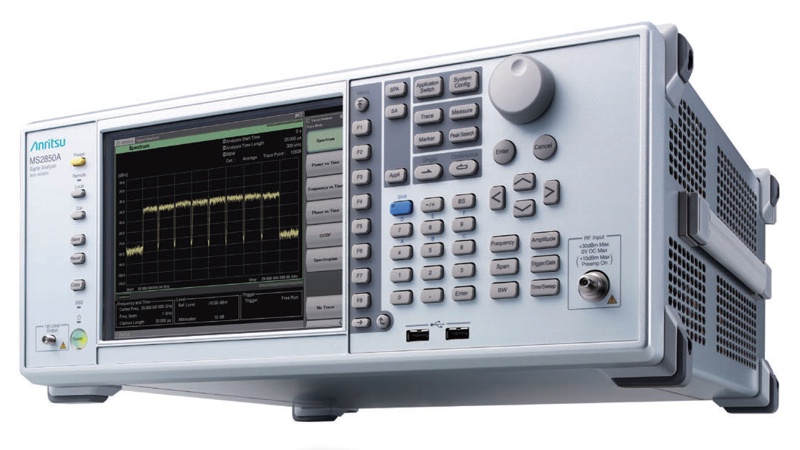
In addition, Anritsu launches a series of laboratory spectrum and signal analyzers MS2830A, which is optimized for measuring the parameters of equipment of wireless communication standards of previous generations: GSM / EDGE, W-CDMA / HSPA +, TD-SCDMA, CDMA2000, EV-DO, HSDPA / HSUPA, WiMAX, WLAN (802.11), Bluetooth and others. This series supports signal analysis up to 125 MHz bandwidth.
Need excellent analog performance? Watch the series Anritsu MS2840A.
It is necessary to measure the parameters of devices mobile communications 2G and 3G? Watch the series Anritsu MS2830A.
Need portable and up to 54 GHz? Watch the series Anritsu MS2090A Field Master Pro.
Need ultra-portable analyzer up to 170 GHz? Watch the series Anritsu MS276xA.
Need real-time spectrum analyzer? Watch the series Tektronix RSA5000B.
You need a spectrum analyzer combined with an oscilloscope? Watch the series Tektronix MDO4000C.
Want to see the full list? This page has everything to choose from spectrum analyzer.
Detailed Spectrum and Signal Analysis
The full operating frequency range is 9 kHz to 32 GHz for the MS2850A-047 and 9 kHz to 44.5 GHz for the MS2850A-046. In this range, the MS2850A analyzers work like classic sweeping (scanning) spectrum analyzers, which allows you to measure power versus frequency (spectrum), power versus time (in zero span mode), channel power, occupied bandwidth, power factor in adjacent channel (ACPR) and other parameters.
In addition, at any of the frequencies above 100 MHz, advanced analysis of signals in the 255 MHz and 510 MHz bands is possible, and at frequencies above 4.2 GHz, analysis in the 1 GHz band is possible. The signal in this band is digitized using a high-speed ADC and processed by a specialized processor using the Fast Fourier Transform (FFT) algorithm. This mode allows you to detect very short changes in the spectrum, record a spectrogram, perform vector signal analysis, measure all important wireless network signal quality parameters such as error vector amplitude (EVM), code domain power, and others, as well as display a constellation modulation diagram (diagram -constellation).
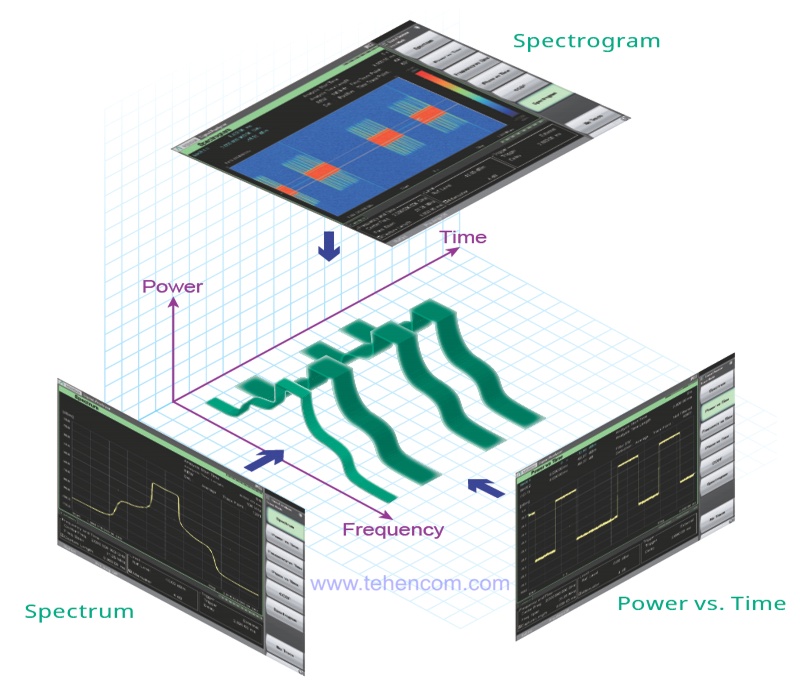
Analysis of up to eight 5G channels in the 1 GHz bandwidth
The Anritsu MS2850A Series analyzers allow you to simultaneously perform detailed analysis of multiple 5G carriers with a bandwidth of 100 MHz each. As standard, these analyzers support a signal analysis bandwidth of 255 MHz, allowing simultaneous operation with two 5G carriers. When the analysis option is set to 510 MHz, simultaneous operation with four carriers is possible, and when the analysis option is set to 1 GHz, simultaneous analysis of eight carriers is supported. For example, this screenshot shows the spectrum of 8 carriers of a 5G signal, the width of each channel is 100 MHz.
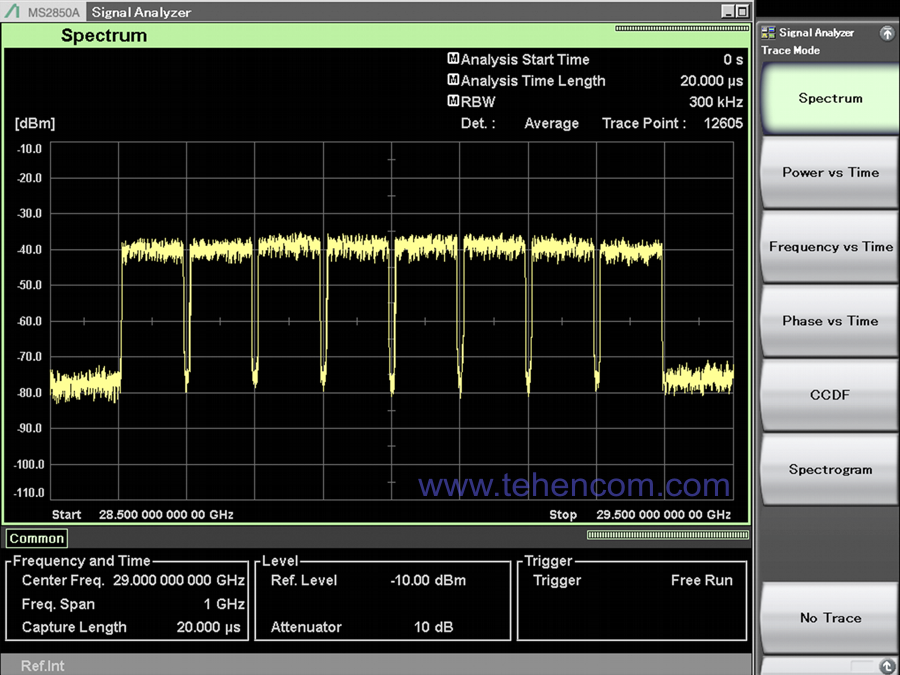
Complete information on each channel
For each measured channel, the Anritsu MS2850A spectrum and signal analyzers provide very detailed information on all signal modulation quality indicators and a lot of other important information. In total, more than 20 numerical parameters are measured and 6 types of graphs are displayed. The main parameters and five types of graphs are also measured in the multi-channel analysis mode. As an example, this table lists the measured parameters for 5G signals.
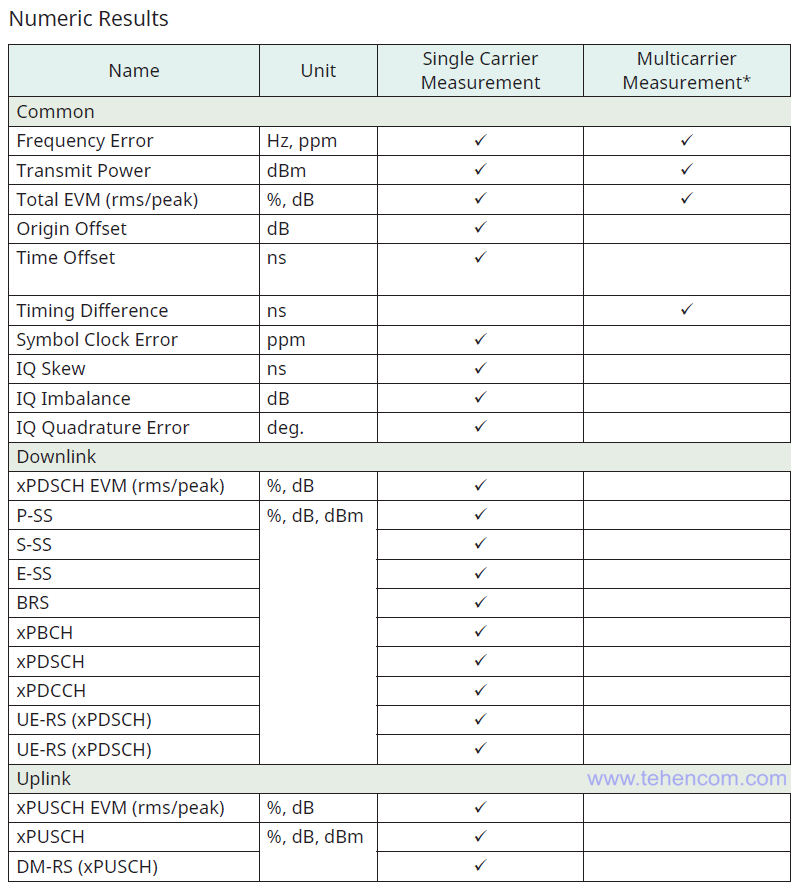
This screenshot shows the screen of the Anritsu MS2850A when analyzing the downlink of an LTE-TDD signal. The constellation diagram (modulation constellation diagram) is displayed on the left side. To the right of it are numerical measurement results: frequency error, output and average power, root mean square (RMS) and peak value of the amplitude of the error vector (EVM), etc. In the lower part there is a graph with changes in RMS and peak EVM values. As you can see, all information about the quality of the signal modulation is clearly and understandably presented on one screen.
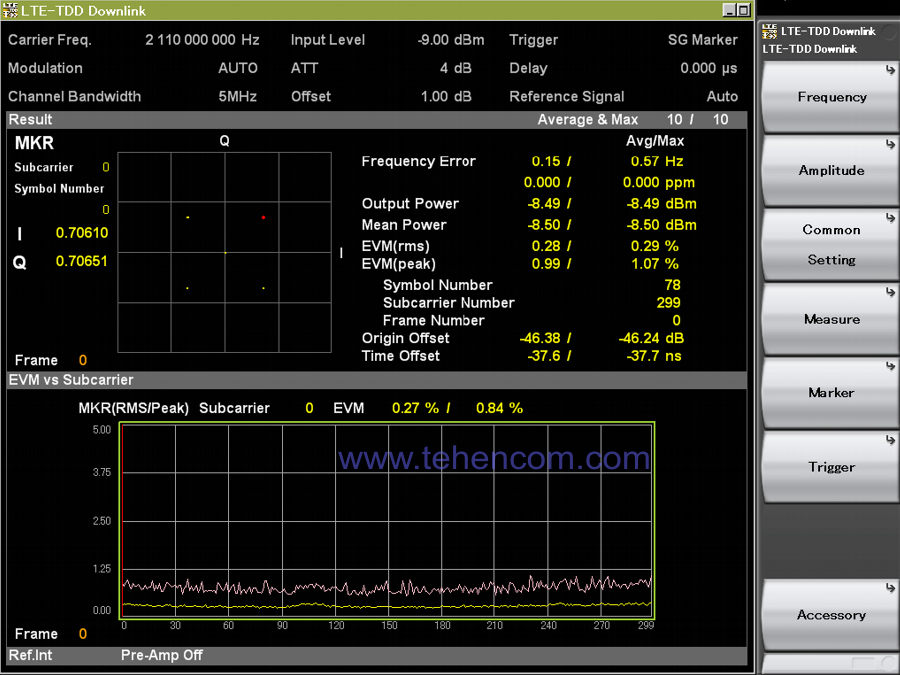
High accuracy measurement of wideband signals
The Anritsu MS2850A analyzers have very high accuracy in measuring the parameters of signals with wideband digital modulation. Due to their uniformity and wide dynamic range, when analyzing a 100 MHz 5G carrier with 64QAM xPDSCH modulation, they provide an error vector measurement error (EVM) of less than 1%.
And in a full 1 GHz analysis bandwidth, the Anritsu MS2850A analyzers have record-breaking amplitude and phase uniformity. So, with a center frequency of 28 GHz and an analysis bandwidth of 1 GHz, the amplitude unevenness does not exceed 1.2 dB, and the phase linearity is better than 5 degrees.
To achieve such high performance, the designers of the Anritsu MS2850A series used an ADC that does not saturate (does not overflow) even with an input level of 0 dBm. This design approach provides a significant advantage and increases the accuracy of the analysis of 5G, 4G and other broadband signals.
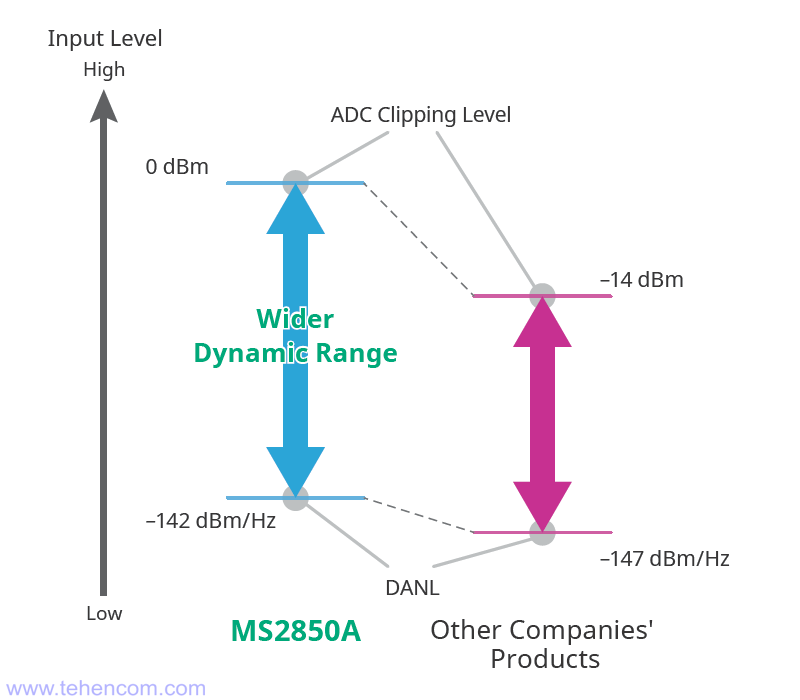
Differences between Anritsu laboratory analyzers
Currently, the Japanese company Anritsu produces four series of laboratory spectrum and signal analyzers: Anritsu MS2830A, Anritsu MS2840A, Anritsu MS2850A and Anritsu MS269xA. All of them are made in a classic desktop case and have a unified user interface. However, these four series differ in terms of features (options), measurement accuracy and cost.

Series Anritsu MS2830A (up to 43 GHz) belongs to the middle class, both in terms of measurement accuracy and cost. It provides an excellent price/feature ratio and is well suited for a wide range of spectrum and signal analysis applications. It is worth emphasizing the excellent opportunities for working with commercial communication standards, for example: LTE, W-CDMA, GSM, WLAN, etc. (excluding 5G). The MS2830A Series instruments can analyze signals up to 125 MHz bandwidth, however, if the analysis bandwidth exceeds 31.25 MHz, then there must be no other signals outside the analyzed bandwidth, otherwise image frequencies will be generated.
Series Anritsu MS2840A (up to 44.5 GHz) has improved performance compared to the MS2830A, especially in terms of phase noise at small offsets from the carrier. Demodulation of commercial communication standards is not supported, but the MS2840A series is great for developing and configuring devices using proprietary digital modulations based on QAM, APSK, etc., as well as various analog modulations. Like the MS2830A Series, the MS2840A Series can analyze signals up to 125 MHz bandwidth, however, if the analysis bandwidth exceeds 31.25 MHz, then there must be no other signals outside the analysis bandwidth, otherwise image frequencies will be generated.
Series Anritsu MS2850A (up to 44.5 GHz) provides the same measurement accuracy as the MS2840A series, plus it can demodulate and analyze signals in a record-breaking 1 GHz bandwidth. This series is ideal for designing and customizing 5G equipment, as well as any devices that use wide modulation bandwidths, such as satellite communications systems or native broadband digital communications systems. Commercial standards (LTE, W-CDMA, GSM, etc.) are also supported. In addition, the MS2850A Series analyzers can record up to 3.9 GS/s of digitized signal to internal memory and transfer it to a computer for advanced analysis, while sampling rates can reach 1.3 GS/s, which allows you to analyze any signal in detail, including impulse.
Series Anritsu MS269xA (up to 26.5 GHz) belongs to the high class in terms of measurement accuracy, and costs a little more than the MS2840A series. The main feature of the MS269xA series is the ability to analyze signals with a bandwidth of up to 125 MHz without the appearance of mirror frequencies. Demodulation of commercial communication standards is supported: LTE, W-CDMA, GSM, WLAN, etc. 5G demodulation and analysis is also supported.
All series of Anritsu laboratory spectrum and signal analyzers can be equipped with a variety of additional options that solve various practical problems, for example: EMC preliminary tests, phase noise measurements, complex waveform generation with built-in vector generator, high-precision frequency measurements with built-in rubidium reference generator, etc. Please note that when using external mixers, the operating frequency range of some laboratory analyzers can be extended up to 325 GHz.
Automation of measurements
The spectrum and signal analyzer Anritsu MS2850A is equipped with all the necessary interfaces for connecting to a computer and integrating into automated measuring systems: Ethernet, USB and IEEE-488 (GPIB). These interfaces are located on the rear panel of the device along with connectors for connecting an external clock signal (5, 10 or 13 MHz), an external sweep trigger signal, an auxiliary noise source control output, and others.
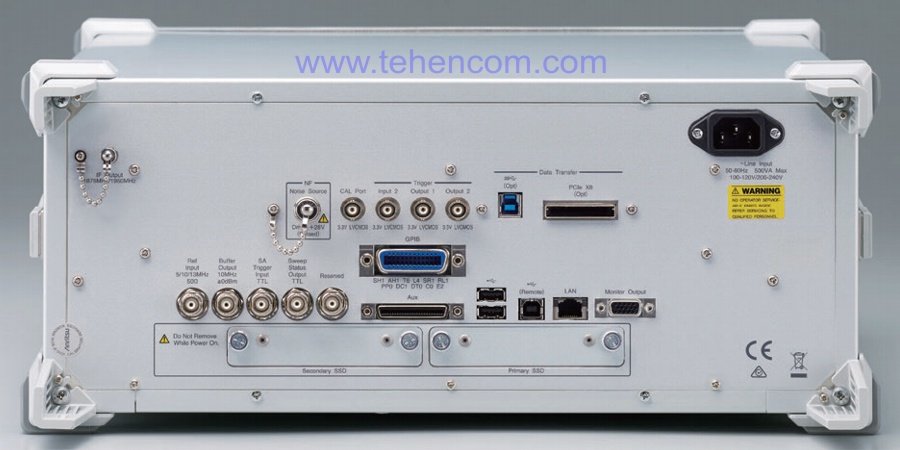
Specifications of Anritsu MS2850A
This figure lists the main technical specifications of the Anritsu MS2850A Series analyzers. Detailed specifications span 36 pages in the PDF file and can be found below on this page in the section Documentation.
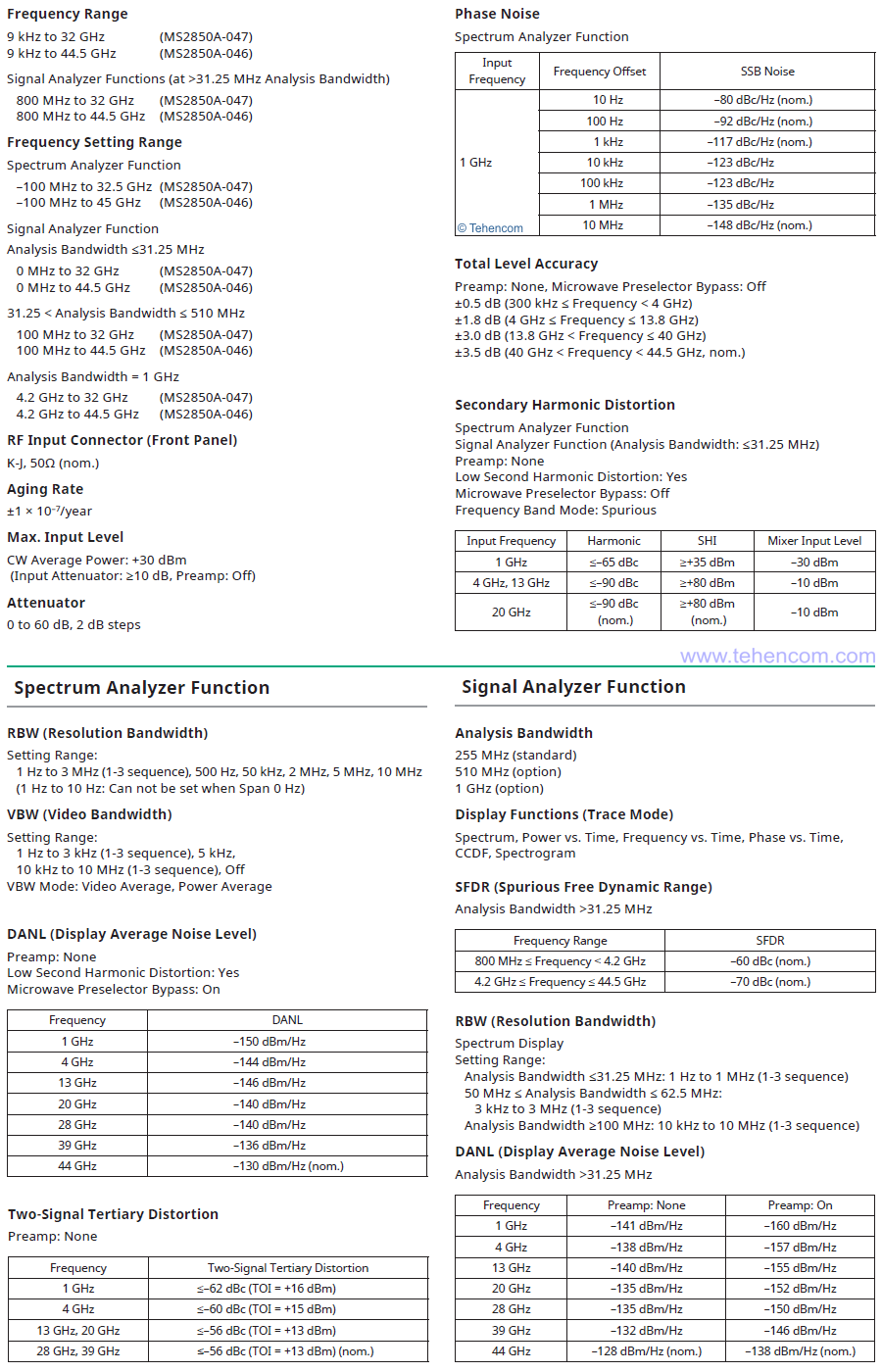
Anritsu MS2850A package contents
| Name | Short description |
| Anritsu MS2850A-047 | Spectrum and signal analyzer (9 kHz - 32 GHz) with options installed: MS2850A-032 (analysis bandwidth 255 MHz), MS2850A-067 (preselector bypass), MX269000A (basic signal analysis software). |
| or | |
| Anritsu MS2850A-046 | Spectrum and signal analyzer (9 kHz - 44.5 GHz) with options installed: MS2850A-032 (analysis bandwidth 255 MHz), MS2850A-067 (preselector bypass), MX269000A (basic signal analysis software). |
| plus: | |
| - | CD with software and documentation |
| - | USB flash drive |
| - | USB computer mouse |
| - | Power cable |
| - | 1 year warranty (can be extended to 3 and 5 years) |
Options and accessories for Anritsu MS2850A
This section lists the hardware and software options for the Anritsu MS2850A series signal and spectrum analyzers. Hardware options are additional electronic modules that enhance the performance and extend the basic capabilities of the analyzers. Hardware options are usually installed during the manufacturing process of the instrument. Their list is contained in the table below.
The MS2850A comes standard with an analysis bandwidth up to 255 MHz (Analysis Bandwidth 255 MHz) and a preselector bypass (Microwave Preselector Bypass). Other options (preamplifier, reduction of distortion due to the second harmonic, measurement of phase noise and noise figure, as well as extension of the analysis bandwidth to 510 MHz and up to 1 GHz) are installed at the request of the customer of the device.
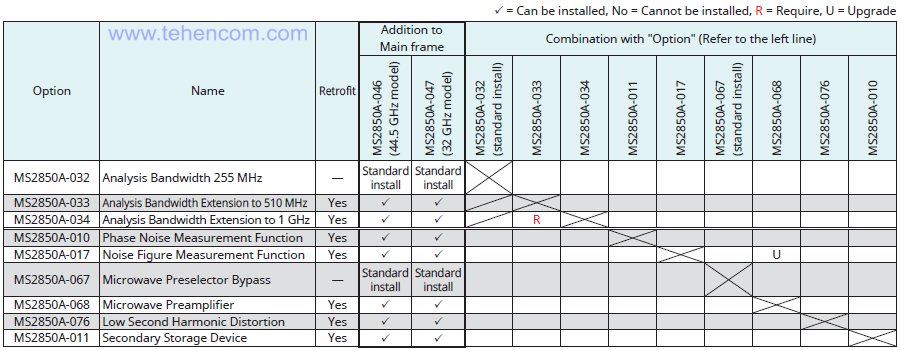
As standard, MS2850A instruments allow you to perform all the basic functions of spectrum and signal analysis: display the spectrum, record the spectrogram of the required duration, measure power, frequency and phase versus time. For in-depth analysis of various wireless data standards, special software options are available, for example, for GSM/EDGE analysis, option MX269013A must be activated. All software options can be activated when ordering or after purchasing the device.
For a complete list of options with a detailed description, see below on this page in the section Documentation. Also see accessories here: Measuring antennas and microwave accessories.
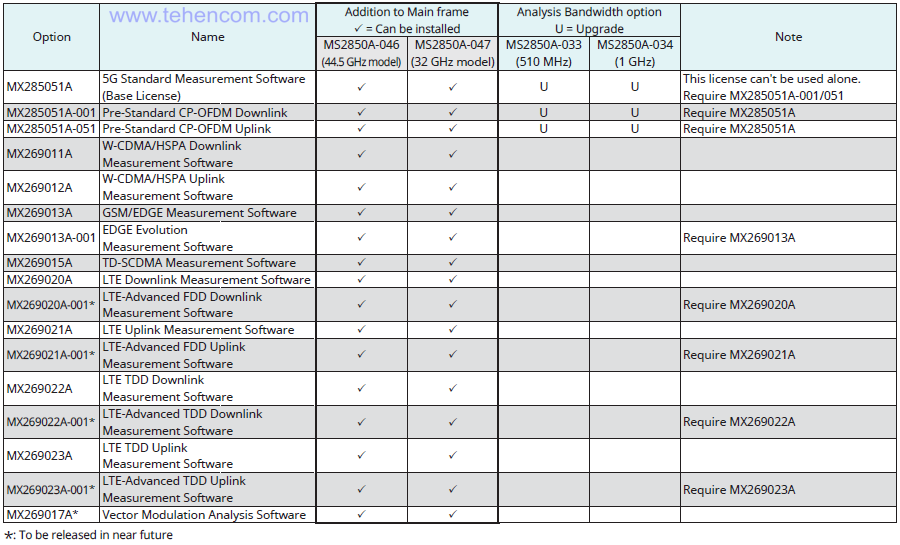
Documentation
This PDF documentation contains the most comprehensive description of Anritsu MS2850A Series Spectrum Analyzer features, specifications and modes of operation:
Description of Anritsu MS2850A analyzers (in English) (32 pages; 5 MB)
Anritsu MS2850A analyzer specifications (in English) (36 pages; 1 MB)
Measuring software for Anritsu MS2850A (in English) (86 pages; 7 MB)
And here you can find our tips and other useful information on this topic:
Basic theory for spectrum analysis and signal analysis
How to buy equipment cheaper – discounts, special prices, demo and used devices
To simplify the process of choosing a spectrum and signal analyzer, you can use our experience and recommendations. We have over 20 years of practical supply experience and can immediately answer many questions about models, options, delivery times, prices and discounts. This will save your time and money. For this it's simple call us or write to us at E-mail and we will be happy to answer your questions.


